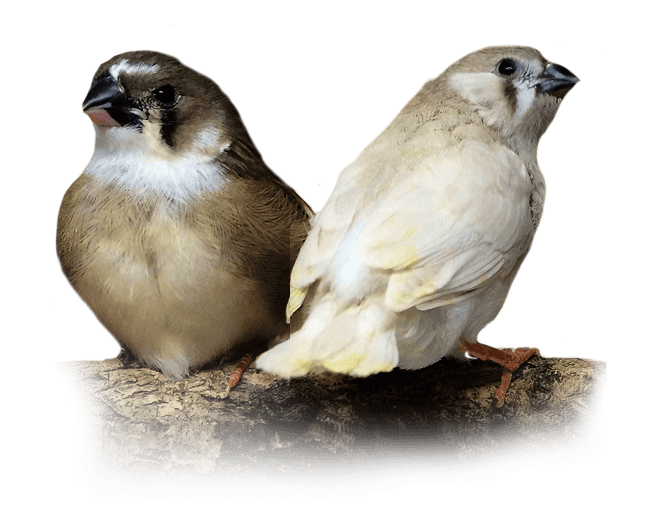Are they as useful as we think?
We take an independent look at some of the common greenfoods that we offer our birds and tests their reputation as ‘must-feed’ elements of diet.

Most people who have kept birds at some point in their life will have heard about the preferred greenfoods for their caged friends and the mythical uses of these foods.
We have all heard about or used groundsel (Senecio vulgaris) with canaries, parrot-type birds and finches. Some may have even had it drummed into them that groundsel increases the song of singing birds. They certainly seem to like this plant, but is there any truth in this statement?
It is well documented that groundsel has a lethal dose of toxins, which affect other animals, such as dogs, cats and horses, owing to the pyrrolizidine alkaloids it contains. In big enough doses, these compounds will cause fatal liver damage. Despite this knowledge, the plant is still recommended in most new and certainly older birdkeeping titles. Is it that birds are immune to these compounds or do these alkaloids simply not affect them?
When feeding my birds, I have many favourite seeds and add-in mixtures that I use. I believe niger seed is a vital addition to the staple diet, and offer this in finger draws every other day to my finches. On the days that I don’t offer niger seed, I provide my birds with a good quality softbill mix. I am currently experimenting with this routine, but they seem very keen to eat both offerings with delight. Lamb’s lettuce, rocket, carrot strips, groundsel and dandelion are also offered to most of my finches at least once a week. Do these plants offer anything extra or is it more worthwhile to rely on synthetic supplements?
It was this thought, as I sat in my garden, that spurred me into researching a couple of the treat plants that I commonly offer to my birds. Is there a mythical “elixir” to song and 100 per cent fledging?
Should we offer a single source of greenfood, or does the sensible notion of “a little of what you fancy does you good” hold sway when it comes to birdkeeping?
The almost zero fat content of dandelion makes it an ideal regular treat food without the risk of obesity.
First, I looked at groundsel and while I could find no nutritional information about this plant, there were plenty of warnings about its toxicity. In an old cage and aviary bird book that I recently read, it stated that canaries in the nest should be offered this plant daily until fledged. I wonder if this plays a part in “going light” or any of the other worrying fledging conditions.

Tuck in, lads, it’s had the thumbs up!’ As a result of his investigation, John believes that carrot, as well as dandelion, can be given to birds as part of a balanced diet all year round.
Carrot, a fairly good source of supplementary food, contains a small amount of vitamins. However, many believe it contains plenty of vitamin A. In fact, 28g of carrot only contains 1.7mg of vitamin C and just 4677 IU of vitamin A. This food is also a mild anti-inflammatory and contains a small amount of the usual vitamins and trace elements common to plant matter, such as vitamin K, E and folates. I expect that the lutein content does have an effect on birds and, as such, is a good addition to all collections. Carrot has also been used for many years as a colour food to help colour up birds. Next on the list was dandelion (Taraxacum officinale). This plant is the bane of a gardener’s life but, I believe, is persecuted beyond what is reasonable. Dandelion is commonly used as a food for many reptiles and it is accepted by many that it has a positive effect on them. However, little is known about what the leaves and flowers actually contain and whether it is of any use to caged birds.

A healing habit: dandelion is reported to provide relief from mild stomach problems and is believed to have antibacterial and antifungal properties.
Low in calories, dandelion also has a low fibre content and is made up of 47 per cent water. This plant can either be fed fresh or dried, and because it contains almost zero fat and low protein, it makes it an ideal regular treat food without the risk of obesity in birds. It also contains balanced levels of vitamin B6 and B12, folates and choline and has a good level of omega 3 at 12.3mg.
Nutritional data taken from United States Department of Agriculture and based on 28 grammes of plant matter.
| Dandelion | Values | Carrot | Values |
|---|---|---|---|
| Vitamin A | 2844 IU | Vitamin A | 4677 IU |
| Vitamin C | 9.8mg | Vitamin C | 1.7mg |
| Vitamin E | 1.0mg | Vitamin E | 0.2mg |
| Vitamin K | 218mcg | Vitamin K | 3.7mcg |
| Calcium | 103mg | Calcium | 9.2mg |
| Iron | 1.7mg | Iron | 0.1mg |
| Magnesium | 19.8mg | Magnesium | 3.4mg |
| Phosphorus | 36.3mg | Phosphorus | 9.8mg |
This plant is a natural healer and its reported therapeutic actions include relief from mild stomach problems, cleansing of the liver, probiotic, and anti-inflammatory. It is also believed to have some antibacterial and antifungal properties.
Take caution, though, because the latter actions make dandelion unsuitable if antibiotics are being used or for those birds with long-term gut issues.
As is common with plants, dandelion has no vitamin D content. However, what it does have is a good calcium-tophosphorus ratio. This is an indicator that birds use particular foods, such as dandelion, to obtain key vitamins and minerals and then use the sun’s UVB rays to help make the most of them.
I believe that both carrot and dandelion can be given to cage and aviary birds as part of a balanced diet all-year-round. And, while I could not find a single scientific reason as to why groundsel is good for birds, I did learn plenty about alkaloids and how they can be toxic to certain species of animal. It is my view, however, that no one food source should make up more than 5-10 per cent of a bird’s daily mix.
In the end, variety is the key to successful birdkeeping.

Future ‘pairings’
“I recommend is to watch the natural diets of wild birds, and the relationship that they have with the ecosystems in which they are found. In the next 5-10 years, we will no doubt be coupling up one food group with another as they interact and work with each other. It is in the same way that good hydration and exposure to the sun or artificial UVB rays work with the foods that birds eat, in order to help sustain their wellbeing.”
Article by our expert, John Courtney-Smith, for Cage and Avairy Magazine.













